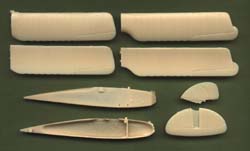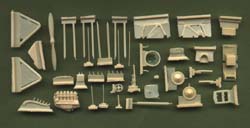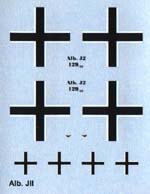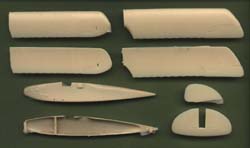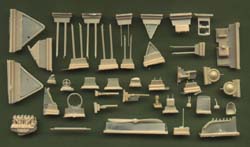Choroszy Modelbud 1/72 Albatros J.I and J.II | 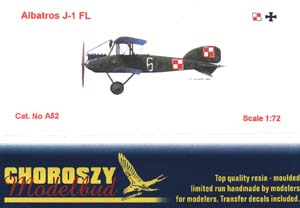
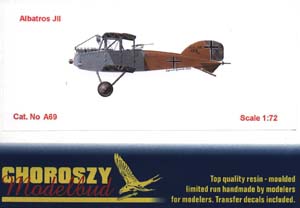
| History In the position war of the WWI Western Front, there were three basic ways of delivering your machine gun to the enemy trenches. The first way was just sending thousands of the poor soldiers, in the hope that some of them will survive the run across the no man's land. But the first years of the war proved that this is very costly and ineffective way, even if the soldiers were supported by the artillery. The second way was to mount the gun onto the armoured, track-equipped vehicle (they call it 'tank', don't they?), which was able to drive safely between the lines, and to capture the enemy trenches. The Allied side chose this way. But the Germans had a third idea: 'why should we invent a tank' they thought, 'if we can just armour the plane?' and so they did. The result was the specification for the so called 'Infanterieflugzeug' ('Infantry airplane'), which took the new letter in the German system of the airplane designation, and so the 'J' planes were born. The 'J' was a two-seater, armoured plane, intended to provide close support to the ground troops. The most important thing for the 'J' was the ability to survive the low altitude mission over the enemy lines in the dense fire of the AA machine guns. It was obvious that the climb, celling and the maximum speed aren't so important in such tasks, so the designers were able to 'trade' them for the possibility of applying armour, and so to use some already existing airframes, with the unchanged engines, to build the 'J' 'flying tanks'. The first three were the AEG J.I, Albatros J.I, and probably the most famous among them, the Junkers J.I. Except the Junkers, which was an original and very futuristic design, the AEG and Albatros were nothing more than 'C' planes, armoured more or less generously with the 5mm steel. Effect was very easy to predict: planes were slow and sluggish, but SAFE! The Albatros J.I was a design that merged the new armoured fuselage with wings, engine and tail from the Albatros C.XII. The 240 airframes were built, and went into action in the late 1917. It turned out to be design succesfull enough to attract the Austro-Hungarian authorities to buy three of them, but it was also obvious, that the design can be improved, as the Albatros J.I lacked engine armour! The improved version, the Albatros J.II, had armour generously applied over the cockpit and the whole nose section, and also slightly modified wings and ailerons, but in fact was very similar in appearance to its predecessor. The J.II reached the front in August 1918 and only 20 of them were built. The kits Choroszy Modelbud, one of the three or four top Central European resin kits manufacturers produces three different kits of the Albatros 'J' planes: Albatros J.I without the spinner and with the decals for the Austro-Hungarian and post-war Polish plane (kit no. A 44), J.I with the modified nose and spinner, with the German decals (kit A 66), and Albatros J.II (kit A 69) with the German decals. The kits A 44 and A 69 are subject of this review. The kits include about 50 parts each, all of them cast in the tan-coloured resin. The fuselages are moulded in standard for the long-run kits left-and-right halves, with the very nice interior and exterior details. The wings are extremely well rendered, with the visible, but delicate ribs, and the trailing edges are as sharp as a knife. All the wing parts are equipped with the precisely placed pins, making their joining with the fuselage and with the each other simpler even than in some modern plastic long-run kits. The control surfaces looks very well too, I especially like the ailerons, which look extremely realistic. The smaller details are also very good. Engines are a masterpieces, cockpits are full of the details, and the radiators looks very good too. Machine guns are the top quality and very realistically 'beefy'. The struts are rather simple, but look like strong enough. Undercarriage legs are very nice, and also look very strong. Albatros J.I has decals for the two schemes, one Austro-Hungarian, and one Polish from the Polish-Bolshevik war 1919-20. Albatros J.II has one scheme for the very late-war German plane in the plain finish, with the lozenge wings, wooden fuselage and dark grey armour plates and very thin crosses. All the decals are well printed and have high quality, very thin decal film. Conclusion If I weren't spoiled by the previous Choroszy's kits, I'd say that the two Panzer Albies are simply stunning. The parts are very well cast in the strong, stiff and easy to deal with resin, the surface details are extremely well rendered, the fit of the parts is excellent, and there are even some holes and pins facilitating joining the parts, which feature is very rare in the resin kits. The decals are very well printed, and the instructions are clear. But there is one reservation: these kits, as every resin kits, aren't for the beginner! My thanks to Mr. Tomasz Choroszy, the producer, for the review kits. | 








|


